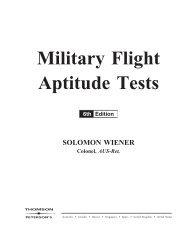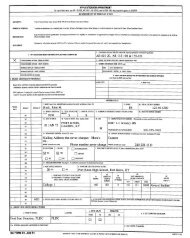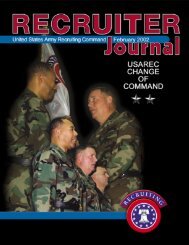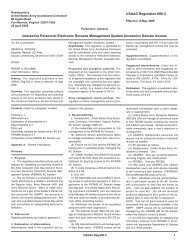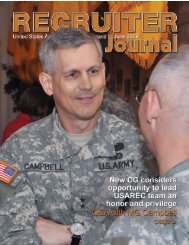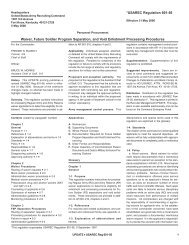19 Dec Cover.pmd - USAREC - U.S. Army
19 Dec Cover.pmd - USAREC - U.S. Army
19 Dec Cover.pmd - USAREC - U.S. Army
You also want an ePaper? Increase the reach of your titles
YUMPU automatically turns print PDFs into web optimized ePapers that Google loves.
(7) Who or what caused the events to happen?<br />
(8) Were any other parties involved but not initially identified?<br />
(9) How or why the events occurred?<br />
e. Who are the immediate supervisors, and where were they when the events occurred?<br />
f. Is each witness credible - if not, why not? Describe the demeanor of the witness and why the demeanor leads<br />
you to believe the witness is credible or lying. Ask yourself whether any witness has an incentive to lie. If so,<br />
explain what that incentive is, why you think it is important, and why you believe the witness is lying (or not).<br />
g. Are there any unanswered questions or issues? Do you have to re-interview a witness or witnesses to clarify<br />
or explain an important fact.<br />
h. Is each proposed finding supported by a greater weight of the evidence than supports a contrary conclusion?<br />
Does the evidence point to a particular conclusion that is more credible and probable than any other conclusion?<br />
(This is the preponderance of evidence standard described by AR 15-6, paragraph 3-9b.)<br />
9. Preparing your report<br />
a. As an exception to policy DA Form 1574 (Report of Proceedings by Investigating Officer/Board of Officers)<br />
will not be used for the Report of Informal Investigations conducted within <strong>USAREC</strong> unless specifically directed<br />
by the appointing authority in the memorandum of appointment. Informal investigations will be reported using the<br />
format at figure 3. Use tab dividers between each enclosure. Be sure to include an index of tabs. If the ROI is over<br />
25 pages, fasten the entire ROI together at the top with a two-hole fastener or place in a three-ring binder. An<br />
example of a good ROI is at figure 4. An example of a poor ROI is located at figure 5.<br />
b. During your investigation, evaluate the evidence concerning each element of proof for each allegation. Be<br />
certain you have obtained the best quality information possible concerning each element of proof. Be sure that you<br />
have done everything within reason to establish or refute each allegation.<br />
c. Remember your audience. The command is relying on you to establish what happened so they can make the<br />
best decision possible. You are the only one who can observe the witnesses demeanor as it relates to credibility.<br />
You will have to sort through conflicting, self-serving statements. You will have witnesses who can’t remember any<br />
important details. In the end, a person who knows nothing about your case must be able to read your investigation,<br />
understand what happened, and understand why you are making the recommendations you are making.<br />
d. Discussion. You should discuss each piece of evidence in light of the facts you ascertained and other evidence<br />
you collected. If there are inconsistencies, you must attempt to resolve them. Do not ignore contradictions or<br />
assume explanations. The IO’s main task is to ascertain facts, not speculate without an evidentiary basis. However,<br />
it is permissible to draw reasonable inferences from the evidence. When referring to witness statements or other<br />
evidence, identify the reference and its location (for example, statement by SGT ______ (Tab _____)). If necessary,<br />
witnesses may have to be interviewed again.<br />
e. Findings. Apply the preponderance of the evidence standard of proof to the elements of the allegation, reviewing<br />
again the regulation defining any misconduct. Findings for each allegation should be that it is either substantiated<br />
(proven) or unsubstantiated (not proven). Unsubstantiated means the truth of the allegation could not be determined<br />
or the allegation was determined to be untrue. After you have determined your findings for each allegation, determine<br />
whether you have developed any information which leads you to additional findings concerning the subject matter<br />
of your investigation. A systemic problem in this subject area may be discovered, and must be reported, with<br />
recommendations. Ensure that the final report accurately reflects the scope and weight of the evidence assembled<br />
in the ROI. Do not misquote or enhance a sworn or unsworn statement from a witness. Ensure that the evidence is<br />
properly documented in your report. For example, if you have a local police department verify a finger print, have<br />
that person sign a letter or statement as to the results of their analysis. Do not include this evidence unless you have<br />
obtained documentation confirming the results.<br />
f. Recommendations. The recommendations must be supported by the findings. If the investigation involves<br />
misconduct or an RI, the recommendations should include the appropriateness of disciplinary action. This may<br />
include recommendations of judicial (courts-martial), nonjudicial (Article 15), administrative (for example,<br />
separations, reliefs, memoranda of reprimands, etcetera,) or no action, other than closing the investigation.<br />
Recommending specific improvements to the system may also be appropriate. Remember that objectivity and<br />
professionalism must be applied to provide responsible, helpful recommendations. Unless you have brought<br />
additional items to the attention of the appointing authority and have been told others would pursue them, a<br />
recommendation for case closure is appropriate.<br />
<strong>USAREC</strong> Pam 27-65 • 20 <strong>Dec</strong>ember 2012<br />
5



